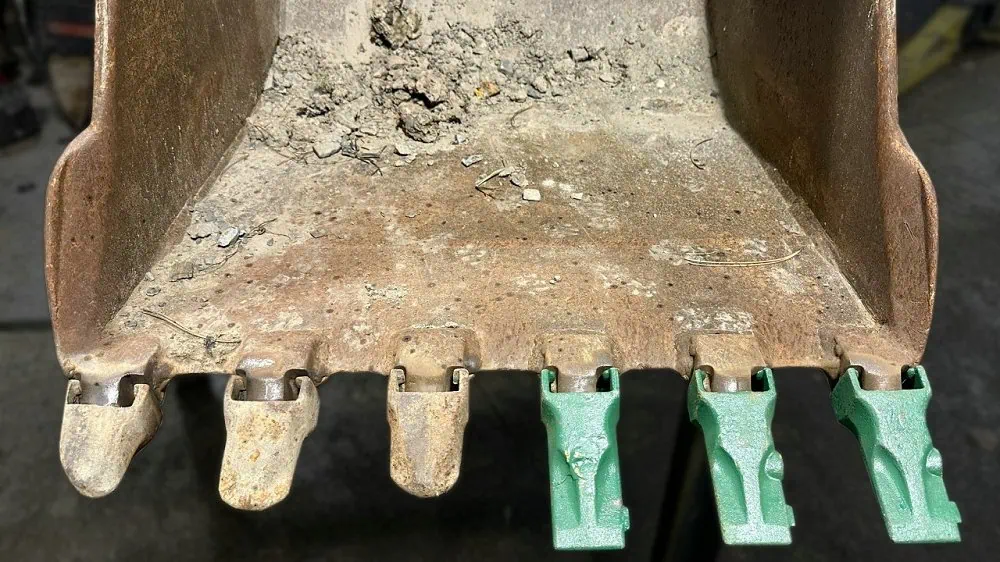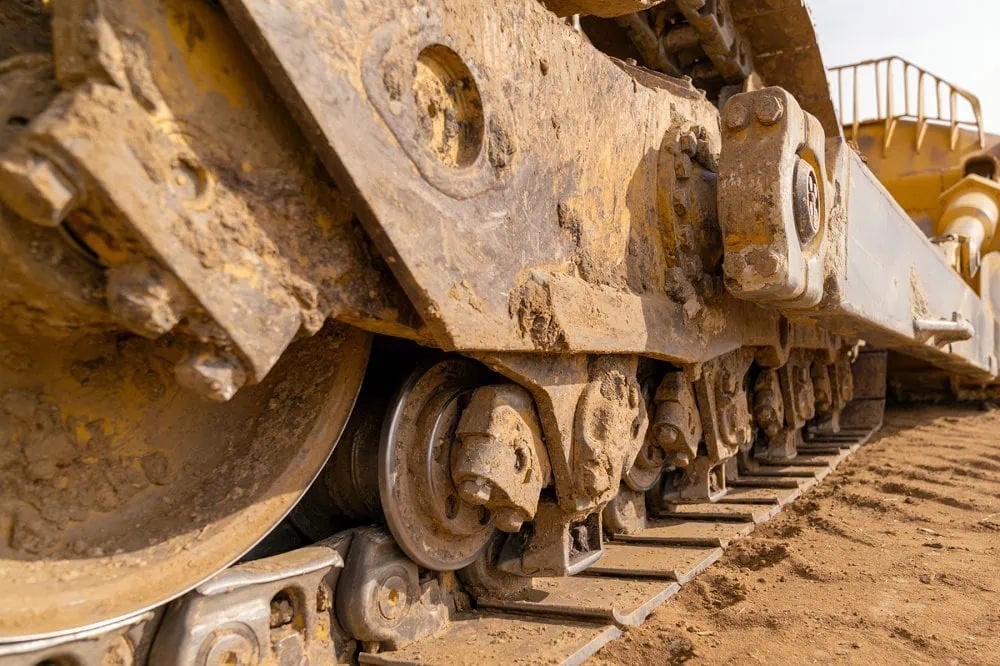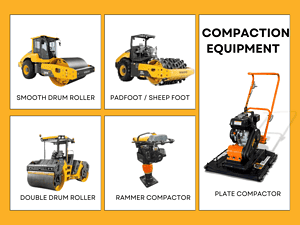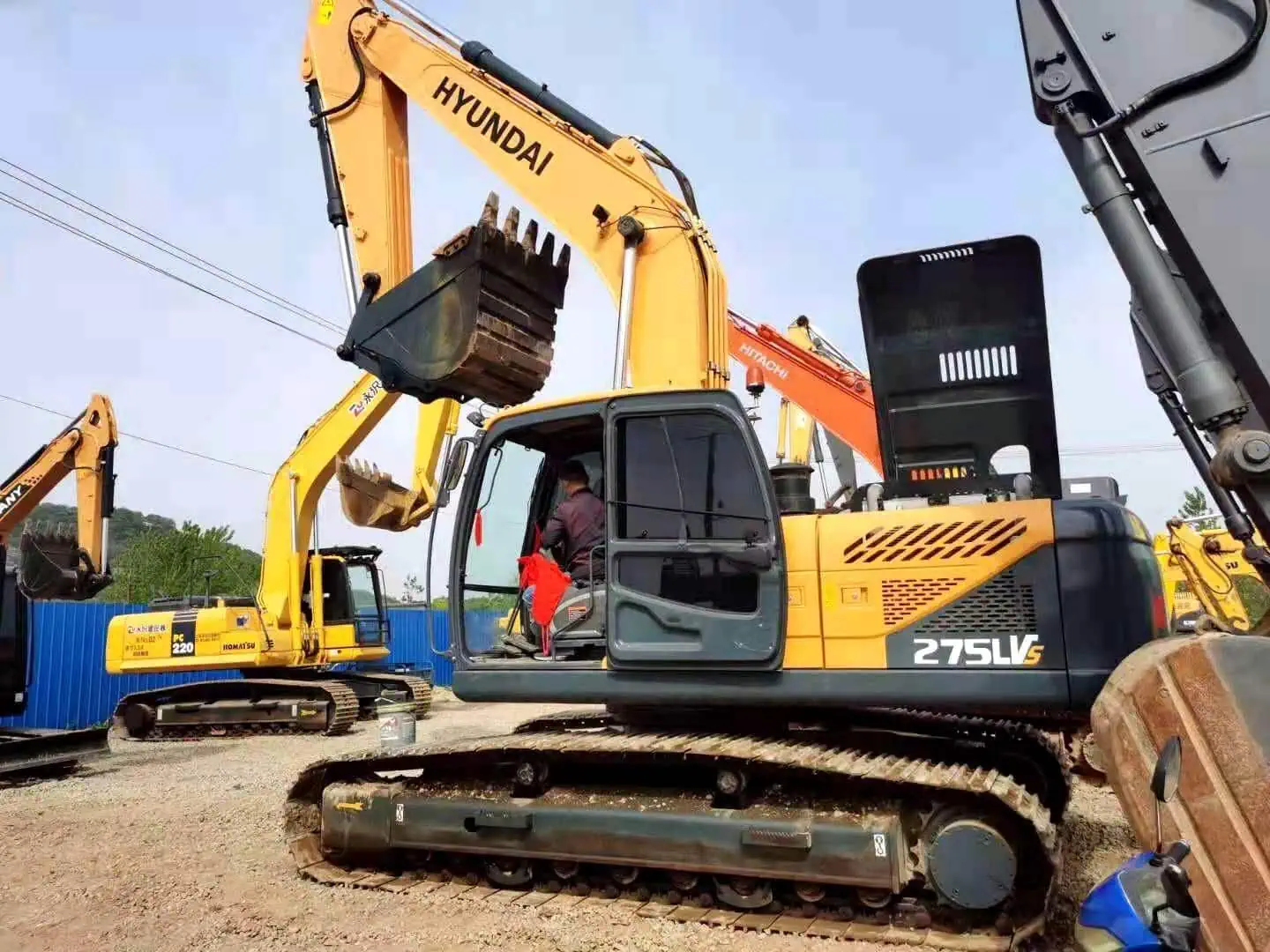You want to keep your excavator running at its peak but you can’t do that if you forget to replace your wear parts. That’s a guarantee. If you neglect your bucket teeth, undercarriage, or hydraulic seals you are going to find yourself running far less efficiently on your jobs and far more in the repair shop. Here are the three main areas where you need to keep an eye on your excavator wear parts.
Excavator maintenance is key to keeping your machine running smoothly. Regular replacement of wear parts like bucket teeth, undercarriage components, hydraulic seals, and more ensures optimal performance and avoids costly repairs. By staying on top of these parts, you can extend the lifespan of your excavator and reduce downtime. This guide helps you identify which parts need replacement and when to take action.
Now you know why wear parts are so important, so let’s look at a few of the most important excavador wear parts and what to do with them.

Tabla de contenido
PalancaBucket Teeth and Edges
Bucket teeth and edges are crucial for digging and material handling, as they are the parts of the bucket that come into contact with the materials being dug or handled. As a result, they are the parts of the bucket that will wear out and need to be replaced the most often. These parts are subject to high-impact situations, especially when operating in harsh conditions such as solid rock or hard-packed soil or debris. These teeth and edges need to stay sharp and intact in order to keep your excavator running its best.
Signs of Wear
- Loss of sharpness: The most noticeable sign that your bucket teeth need to be replaced is when they become dull. Dull teeth will not dig as efficiently, and you will consume more fuel in the process.
- Cracks or breakage: If any of your teeth are cracked or broken, they can be dangerous and may cause further damage to the bucket or other surrounding parts.
- Excessive wear on edges: If the edges of the teeth become rounded, you will not be cutting evenly, which will affect the machine’s performance and your productivity.
Replacement Frequency and Options
Teeth should be replaced every 500 to 1,000 hours, depending on the type of work the machine is doing. If you’re digging in rock, you’ll have to replace them more often.
There are two main options for replacing bucket teeth:
- OEM (Original Equipment Manufacturer): These are parts manufactured by the company that made the original equipment. They will give the best fit and performance.
- Aftermarket: These parts may be cheaper than OEM parts, but fit and quality can vary depending on the manufacturer
Maintenance Tips
- Regular inspection: Regularly inspect the teeth and edges for signs of wear, cracks, or loss of sharpness.
- Replace individual teeth: Instead of replacing the entire bucket, consider replacing only the teeth that are worn.
- Use high-quality parts: Always use high-quality replacement parts to make your bucket last longer.
Bucket Teeth Wear Table
| Wear Part | Sign of Wear | Replacement Frequency | Recommended Maintenance |
| Bucket Teeth | Loss of sharpness, cracks | Every 500-1,000 hours | Inspect regularly, replace worn teeth, use OEM or quality aftermarket parts |
| Bucket Edges | Chipped, bent edges | Every 500-1,000 hours | Inspect edges, replace when excessively worn |

Undercarriage Components
The undercarriage is the foundation of the excavador. It supports the weight of the machine and provides mobility to move over rough terrain. The main components include the tracks, rollers, idlers, sprockets, and track links. These components are in constant contact with the ground and take a beating. Sooner or later, they will need to be replaced.
Factors Leading to Wear
- Rough terrain: Operating on rocky or rough surfaces will put more strain on these parts, causing them to wear faster.
- Improper tension: If you’re not tracking the tension properly (either too tight or too lose), it can cause uneven wear on the tracks and the sides of the rollers and sprockets.
- Poor maintenance: Not maintaining the undercarriage, not cleaning or lubricating it, will cause it to wear out prematurely.
Indicators of Wear
- Track sagging: If you see your track sagging or visually see that the pitch of the chain is longer than when the machine was new, then the chain is stretched and needs to be replaced or adjusted.
- Rollers worn out: If the rollers are no longer smooth or have become noisy, they need to be replaced to avoid damage to the track links.
- Sprockets and track links: If there’s excessive wear or deformation, the track links won’t mesh with the sprockets the way they need to, and the machine won’t move as well as it should.
Costs and Impact on Machine Performance
The cost of replacing the undercarriage is significant, but it’s a necessary investment to keep your machine running. Otherwise, neglecting it can result in:
- Decreased fuel efficiency.
- Poor performance in difficult terrains.
- Increased downtime and repair costs.
Undercarriage Maintenance Table
| Component | Sign of Wear | Replacement Frequency | Recommended Maintenance |
| Tracks | Sagging, excessive wear on rubber | Every 2,000-3,000 hours | Inspect regularly, adjust tension, clean tracks |
| Rollers | Noise, rough movement | Every 2,000-3,000 hours | Clean and lubricate rollers regularly |
| Sprockets | Worn teeth, uneven wear | Every 3,000 hours | Replace when teeth show significant wear |
| Track Links | Cracks, loose links | Every 2,000-3,000 hours | Inspect and replace damaged links |
Hydraulic Seals and Hoses
The hydraulic system on an excavator is what powers many of the vital functions of the machine, such as moving the boom and arm. Within that hydraulic system, there are a lot of seals and hoses that must hold pressure and seal around moving parts. Over time, those seals and hoses wear out due to the high pressure, heat, and dirt they see in daily operation.
Symptoms of Wear
- Leaks: If you see any hydraulic fluid dripping from hoses or coming out of the seals, that means they’re worn out.
- Lose pressure: If you see signs of the machine not operating at the capacity you expect, and it’s not just a lack of power but a loss of flow, then it’s probably due to hoses or seals that are worn out.
- Sluggish movement: If your hydraulics are taking longer to respond or don’t seem as fast as they once were, it could be due to worn-out seals or hoses.
Best Practices for Replacing Hydraulic Seals and Hoses
- Inspection: You can’t do this enough. Check your hoses and seals to ensure they’re not leaking or that the hoses aren’t damaged or cracked in any way.
- Replace seals sooner rather than later: When you see that you have a leak or the machine isn’t producing what you expect, go ahead and replace the hydraulic seal. It’s a small price to pay to avoid the damage it can cause by running it with worn-out seals.
- Maintain hydraulic cleanliness: Make sure you maintain the hydraulic oil level and keep it clean. The better you maintain the hydraulic system, the longer those hoses and seals will last.
Hydraulic System Maintenance Table
| Part | Common Wear Symptoms | Recommended Maintenance |
| Hydraulic Seals | Leaks, cracks, visible wear | Replace when leaks are detected |
| Hydraulic Hoses | Fraying, cracking, fluid leaks | Inspect every 500 hours, replace when damaged |
| Hydraulic Filters | Clogged filters, poor fluid quality | Change every 500 hours |

Pins, Bushings, and Bearings
Pins, bushings, and bearings: These are essential for allowing the machine to pivot. As you move the boom, the arm, the bucket; anything that pivots or rotates on the machine requires these components to allow those movements. These are the points where you need pins, bushings, or bearings. They undergo a constant load and have a lot of stress placed upon them, so they wear out easily.
Common Signs of Wear
- Excessive play: If you find a lot of play or movement in the joint, then your pins and bushings are worn.
- Squeaking or grinding: Weird noises and sounds are a frequent sign that your bearings are worn out or need lubrication.
- Hard to move: Everything seems to work, but it’s hard to move or takes a lot of force to make that component work.
When and How to Replace
Keep pins and bushings lubricated with a light application to reduce friction. If you notice excessive play or hear funny noises, it may be time to replace the worn components.
Pins and Bushings Wear Table
| Part | Sign of Wear | Recommended Maintenance |
| Pins | Looseness, excessive movement | Replace when movement becomes excessive |
| Bushings | Excessive play, squeaking | Replace when wear is noticeable |
| Bearings | Grinding, rough movement | Lubricate regularly, replace when noisy |
Final Drive and Transmission Parts
The final drives and transmission are what make an excavator operate. They turn the power from the engine and send it down to the tracks so the machine can maneuver. If you have issues with those components, there is a lot of output loss. Those two areas are under a lot of stress and have a lot of wear because they carry all that load. So, keep an eye on them, and do whatever it takes to make sure the machine is going to last and stay productive.
Common Issues
Excessive Noise or Vibrations:
If you hear loud, unusual noises such as grinding, whining, or clunking, be aware something isn’t right with your final drive or transmission. Often, this noise comes from worn bearings, gears, or other internal components. A lot of moving parts are inside these components, and if you lose a bearing, gear, or shaft, your final drive is going to go crazy. Never ignore loud, obnoxious noises. Get your machine to the shop for repair now before things become worse.
Loss of Power:
If your machine’s pushing power disappears, like when you can’t hardly move to move its own tracks anymore, or if you have push and acceleration problems, the issue almost certainly lies in the final drive and/or transmission. If the final drive is worn out, power transfer isn’t getting to the tracks. If the transmission is shot, you won’t get as much power to the final drives, so you’re going to have no push and struggle to go up a hill, over rough areas, or through mud. Push power loss might also come from power distribution problems, especially when the machine turns or gets on a slope.
Oil Leaks:
An oil leak is one of the most obvious signs your final drive or transmission is on the rocks. Seals, gaskets, and wear rings can wear out over time, plus you can break the housing which then allows oil to escape. If you lose too much oil, the amount of friction increases— to the point you start damaging internal components or causing an overheating scenario. The bottom line is, if you keep losing oil, you’re going to trash the inside of your final drive or transmission, leading to an extremely expensive repair.

When to Replace Final Drive Components
El final drive and transmission require regular inspection to ensure they are in good working condition. Some signs that indicate it’s time to replace these components include:
- Persistent Noise – You will normally hear grinding, clunking, or a lot of noise, which means it is time for a replacement.
- Loss of Performance – If you start losing performance and the machine does not move as it did or does so unevenly over various terrains and pitches, you probably need to replace the item.
- Oil Leaks – Look for oil around the seals, especially if oil is getting out past the gaskets or wear rings. You will see an oil trail because of an oil leak, and when this happens your equipment is really in trouble.
As a general guideline, final drive components may need replacing around 4,000 to 6,000 operating hours, but it’s important to track performance and inspect parts regularly.
| Issue | Sign of Wear | Recommended Action |
| Excessive Noise or Vibration | Grinding or whining sounds | Inspect bearings, gears, or internal components |
| Loss of Power | Sluggish movement or difficulty in moving | Inspect the transmission and replace if necessary |
| Oil Leaks | Visible oil leakage around seals | Replace seals and inspect for cracks in housing |
Other Common Excavator Wear Parts
final drives and transmissions are sensitive, so are the other components of an excavador. They all take a pretty good beating, primarily because that’s what we do in heavy construction. These few basic parts mimic an automobile in that they all take a lot of wear. Keep an eye on these components and replace them as needed to keep everything running at peak performance.
Wiring Harnesses
Wiring harnesses are bundles of wires that route power and signals throughout the excavator. They are subject to wear and damage from the constant movement and vibrations of the machine. Damaged wiring harnesses can cause electrical shorts, loss of power, or malfunctions in various systems of the excavator.
Cooling System Components
The cooling system is essential to keep the engine and hydraulic systems from overheating. Components like the radiator, fan, and hoses can wear out over time due to exposure to heat, pressure, and debris. If the cooling system is not functioning properly, it can lead to engine failure and other critical problems with the excavator.
| Part | Description | Replacement Frequency |
| Rubber Pads | Protects tracks and reduces operational noise | Replace when pads are worn out |
| Swing Bearings | Facilitates smooth rotation of the boom | Replace every 3,000-4,000 hours of operation |
| Seals and Gaskets | Prevents leaks in hydraulic and oil systems | Replace when leaks are detected |
| Filters (Air, Oil, Fuel) | Prevents contaminants from entering the systems | Replace every 500-1,000 hours |

How to Prolong the Life of Excavator Wear Parts
Maintaining the wear parts of your excavator is essential to reduce operating costs and increase the longevity of the machine. Here are some tips to help prolong the life of these crucial components:
Inspect Regularly
As with any equipment, regular inspections are key to catching minor issues before they become major ones. By checking things like the undercarriage, hydraulic seals and bucket teeth, you will save yourself the time and money of dealing with bigger problems later on.
Keep It Lubed
Regularly lubricating moving parts is always a good idea as it reduces friction and wear. This includes things like pins and bushings or the final drive gears. Always follow the schedule laid out in the manual and always use the correct product.
Keep It Clean
Just like the undercarriage, keeping everything else clean on your excavator will keep it running longer. Cleaning out the undercarriage means preventing unnecessary wear and tear. Cleaning out the hydraulic systems keeps you from clogging the system and damaging expensive parts. If you can’t keep up, hire someone to come in and do it.
Use It Right
Make sure the operator is using this equipment with care and proper operating procedures. Overloading the machine, slamming it into forward or reverse, or putting excessive loads on the excavator can wear out a piece of equipment in a hurry. Operating this piece of equipment with a lack of proper maintenance can also mean you are taking months or even years off of your investment.
| Maintenance Tip | Benefits | Recommended Frequency |
| Regular Inspections | Helps detect issues early and avoid major failures | Inspect daily or weekly depending on usage |
| Proper Lubrication | Reduces friction and wear on moving parts | Lubricate daily or per machine’s manual |
| Cleanliness | Prevents debris buildup and damage | Clean daily after use |
| Proper Usage | Extends machine life and reduces unnecessary stress | Follow manufacturer’s operational guidelines |
Conclusión
Regular maintenance, and timely replacement of wear parts, are critical to keeping your excavator running at peak performance. Whether it’s the final drive, the undercarriage or the hydraulic seals, knowing when and how to replace these parts can save you money, reduce downtime and keep your machine operating at peak performance. Inspect, lubricate and keep it clean, and you will see your machine last for years with no serious problems. Don’t wait for it to break. Fix it before it does.
Follow us on :YouTube.










